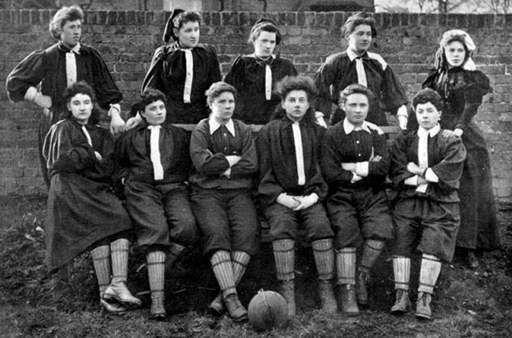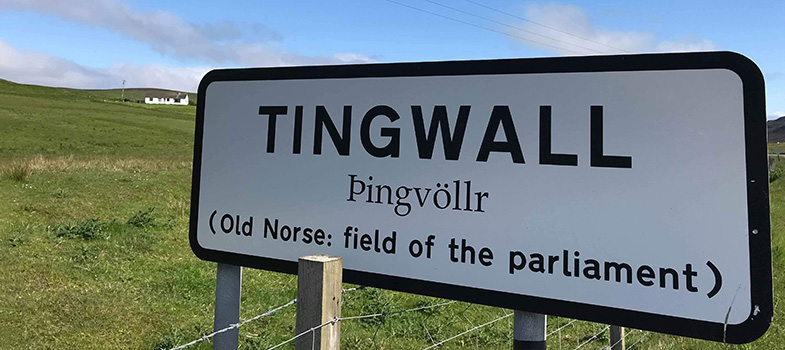8.5 The hidden story of Scottish football
Although the more institutionalised football game as we know it today emerged in the second half of the 19th century, football was already played in Scotland in the early Middle Ages. One of the reasons for this long tradition might be that football is a game that is easy to play – all that is needed are players, a bit of flat ground and a ball of some sort. Simkin states:
“Early games of football in Britain were played with blown-up animal bladders. These tended to burst and eventually most ball games played during the Middle Ages used a more solid ball. According to one historian of this period the ball was ‘usually a leather covering filled with cork shavings or a similar material.’”
And there is a widely neglected aspect of the long history of the game in Scotland, namely women’s football. Women throughout history actually had to fight to be able to play the game publically. BBC Scotland News maintains that “[w]omen's football is flourishing [today], but for centuries the game endured chronic discrimination, sexism and was even banned.” (BBC News, 2013)
Yet, Simkin highlights that Scotland was the place where women appear to have been introduced to the game first:
“[… it] seems to be the first country in the world to encourage women to play football. In the 18th century football was even linked to local marriage customs in the Highlands. Single women would play football games against married women. Single men would watch these games and use the evidence of their footballing ability to help them select prospective brides.”
The BBC Scotland News reports that:
“[c]hurch documents record women playing football in 1628 in Carstairs, Lanarkshire; A kirk session minute of January 1656 details drunkenness and fighting during both men's and women's games played on Fasting's eve; An annual match is said to have been contested by teams of married and single women near Inverness in the 1700s.”

In the 19th century, Scottish women even played international football before their male counterparts did – a fact that tends not to be mentioned in reports about the history of football in Scotland. Here is an extract from the BBC Scotland News article ‘The Honeyballers: Women who fought to play football’ [Tip: hold Ctrl and click a link to open it in a new tab. (Hide tip)] outlining the history of the women’s game in Scotland.
“Britain's first recorded international women's football match was played in Edinburgh in May 1881. A team representing Scotland beat one from England 3-0, with Lily St Clair scoring the opener. In a report following the match, the Glasgow Herald described the Scottish team as looking smart in blue jerseys, white knickerbockers, red belts and high heeled boots. Another game followed a few days later, this time in Glasgow. It had to be abandoned when hundreds of men ran on to the pitch. The players escaped on a bus drawn by four grey horses amid chaotic scenes of vandalism and fighting between spectators and police.
[…] In 1894, medical professionals called for girls and women to be banned completely from playing. However, some determined characters refused to be denied a sport that they were passionate about. The British Ladies Football Club was formed in 1895 with Dumfries aristocrat Lady Florence Dixie as its patron. Team captain was Mary Hutson who played under the pseudonym, Nettie Honeyball. […]
Later, during World War I, there was a brief revival. With thousands of men sent away to fight in the trenches, women took up traditional male roles in work and play. Dr Fiona Skillen, of Glasgow Caledonian University, said: "The First World War is a real critical point for women, especially working class women. […] you find that there is a growth in different kinds of sports, different kinds of leisure activities, because these young women are getting involved with them."
New teams emerged including one from Beardmore's Forge in Parkhead, Glasgow, that played an unofficial match against an English side at Celtic Park on 2 March 1918. Crowds of more than 50,000 turned out to watch games, but the end of the war was soon followed by an official British ban on the women's game in 1921. […] But the women's game survived thanks to the determination of teams both north and south of the border. […] Eventually the ban was officially lifted in the 1970s.”
Activity 11 
After reading the text about the history of women’s football, take some notes about the facts you personally find most interesting and enlightening. You may also want to compare what you have read here with the history of the men’s game.
Answer
This is a model answer. Your answer might be different.
I found this text really interesting as it showed that the tradition of women in football in Scotland is as old as that of men, however, as in other parts of our culture, the women’s footballing history has remained in the shadows of the men’s. I found it fascinating to read that football has provided women with a platform for fighting for their emancipation in Scotland. I was amazed to read that women playing football was part of an 18th century marriage custom in the Scottish Highlands, that the very first international football match was played by women in Scotland, that women’s football during World War I attracted crowds of over 50,000 spectators, and that the ban of women’s football in Britain lasted until the 1970s!
Activity 12
Look at a list of Scottish Football League clubs and their nicknames, which reflect the close connection of the clubs to their local communities.
Can you match the club names with their nicknames? When sorting the nicknames, keep in mind Scotland’s geography and possible local connections. Also think about Scots words you have come across in this course so far. If you need help, as always, go to the DSL.
Drag the nicknames to the position that you think fit with the correct club’s names. Some answers might be easier to deduct than others. Once you have found the right combinations, check the additional information we have provided in the note.
Using the following two lists, match each numbered item with the correct letter.
The Wee Rovers
The Red Lichties
The Wee Gers
The Gowfers
The Jags
The Doonhamers
The Bairns
a.Partick Thistle
b.Queen of the South
c.Carnoustie Panmure
d.Albion Rovers
e.Arbroath
f.Berwick Rangers
g.Falkirk
- 1 = d
- 2 = e
- 3 = f
- 4 = c
- 5 = a
- 6 = b
- 7 = g
Answer
Sport is an expression of culture. Football clubs are mostly named after the area in which they were founded. They are closely related to that area’s heritage, geography or work practices.
Falkirk’s name is taken from the Burgh motto: ‘Better meddle wi' the de'il than the Bairns o' Fa'kirk’. Arbroath take their name from the red light that was used to guide fishing boats into the Burgh’s harbour. The nickname of Queen of the South of Dumfries comes from the words doon hame, down home. Even when they were away, Dumfries people knew, in a deep cultural sense, where they belonged.
Here are some further explanations for the links between the clubs’ names and the nicknames they have been given by their fans. These come from an article on the Scots Language Centre website. On the website you can also listen to a recording with the Scots pronunciation of the nicknames.
Albion Rovers – called The Wee Rovers (the little Rovers). The word wee is, of course, the Scots word for little.
Arbroath – called The Reid Lichties (the little red lights) which is thought to refer to the red light that was used to guide fishing boats into the harbour of Arbroath.
Berwick Rangers – called The Borderers or The Wee Gers (the little Rangers) to distinguish them from Glasgow Rangers.
Carnoustie Panmure – called The Gowfers (the golfers). Carnoustie is, of course, well known for its golf courses. In Scots we say gowf and not golf which is an English pronunciation.
Falkirk – called The Bairns (the children). This nickname is taken from the motto of the burgh of Falkirk which warns: “Better meddle wi the deil than the Bairns o Fawkirk" (better meddle with the devil than the children of Falkirk). In Scots the name of the town is The Fawkirk (the speckled church).
Partick Thistle – called The Jags (the prickles). This derives from the Scots word jag or jaggie which means ‘prick/pierce’ or ‘prickly’ which is a good description of a thistle. The Scots for thistle is thrissle.
Queen of the South – called The Doonhamers (the downhomers). This is the local name for natives of Dumfries and also refers to doon which is one of the Scots words for a goal place (the other more common word for a goal in Scots is a dale.)
And here are some more interesting nicknames and their connections to the clubs:
Ayr United – called ‘The Honest Men’ which is taken from the Robert Burns poem ‘Tam o Shanter’ – ‘Auld Ayr, wham ne’er a town surpasses/ For honest men and bonie lasses’.
Clyde – called The Bully Wee (the good little). This probably derives from the Victorian word ‘bully’, meaning good or first rate and because the club was quite small it was known as the The Bully Wee Clyde (the first rate little Clyde).
Glasgow Rangers – called The Gers or The Licht Blues (the Light Blues) from the original colour of the jersey. In the last few years the motto of the club Aye Ready (always ready) has, for some reason, simply become ‘Ready’, dropping the Scots aye altogether. In Scots the city is called Glesca or Glescae.
Saint Mirren – called The Buddies (the people) which is derived from the Scots body, meaning ‘person’ and often pronounced to sound like buddie.
Please note: It might be useful to look up in the DSL the entries for the Scots words contained in the nicknames you have come across in this activity. This will help you see how these words were derived. To make this easier for you, here the links to the DSL.
Arbroath: The Red Lichties
Clyde: The Bully Wee
Falkirk: The Bairns
Forfar Athletic: The Loons
Montrose: The Gable Endies
Peterhead: The Blue Toon
Queen of the South: The Doonhamers
St Mirren: The Buddies
8.4 The Game of Fitba
